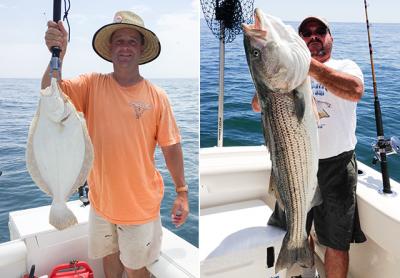Drone Fishing: Where’s the Sport in That?

I’ve avoided writing a column about fishing with drones because, quite frankly, I think it’s an idiotic pursuit. But recently I’ve been getting reports from tackle shops that more and more customers are inquiring about using a drone rather than a surf rod to deliver a baited hook.
In my view, a surf fisherman who uses a drone to send a plug, tin, or bait to feeding fish is no different than a golfer who employs one to drop a Titleist 12 inches from the pin from 450 yards away. Yes, the fisherman will catch more fish, and, yes, the golfer will shoot a record score, but where’s the sport in either endeavor? Sorry. There is none.
Maybe if I fished for the table more than for sport I wouldn’t be so opposed to the concept. But even my friend Tom, an exceptional fisherman who eats more fish than a local gray seal, believes that drone fishing “just doesn’t seem right.” An integral part of any sport is learning, practicing, and perfecting techniques. In surf fishing this applies to casting. Using a drone instead of acquiring the necessary casting skills is almost cheating, like using a corked bat to hit a baseball farther.
A quick tour of the internet indicates that drones designed for fishing are pretty expensive, at a couple grand with accessories and such. Why waste money on something that surely will end up on a dirty garage shelf next to the Roomba? Instead, spend the bucks on a nice rod, reel, and some casting lessons from a local expert.
Using a drone to scout for fish is another story. Captains for years have been using powerful radar to scan for flocks of surface-feeding birds, which typically signal the presence of fish. Drones are simply an evolution of this technology that can save fishermen fuel costs and minimize unproductive time on the water. Drones can also help surfcasters locate schools of fish along the shoreline when otherwise they would have to hoof it down the beach or motor back and forth in their four-wheeler. Of course the angler who is catching fish in solitude will not appreciate the distant operator’s aerial reconnaissance and might respond with an unfortunate errant cast. Oops.
Imagine what would happen during the fall run around Montauk Point if surfcasters sent their plugs way beyond the surf line among the mosquito fleet and boaters dropped their tins into the waters below surfcasters standing on rocks under the Lighthouse. Mercifully, the loud and annoying buzzing generated by a drone’s four rotors would certainly drown out the exchanged pleasantries.
Another electronic device that some fishermen are experimenting with locally is the iBobber, a wireless sonar fish-finding device. Based on info gleaned from the internet, one casts the iBobber into a body of water and either lets it sit or slowly retrieves it. The device allegedly maps the contour of the bottom and detects fish swimming underneath its location. The captured information is then transmitted to and displayed on the angler’s smartphone. Does it work? Maybe in a still pond but unlikely in a moving current. The iBobber costs less than $100 so the cost of early adoption isn’t crazy high.
David Reutershan from Gone Fishing Marina in Montauk reported that “the bite is on,” despite the hot weather. On Tuesday, a charter boat returned by lunch limited out on bass and sea bass, with stripers up to 41 pounds. Boaters have been catching keeper fluke, and a private captain came back early one morning this week because he got tired of catching so many fish.
“Loads of weakfish” have made an appearance near inlets in the bays to the west, said Sebastian Gorgone of Mrs. Sam’s Bait and Tackle in East Hampton. “There are big schools with some keepers,” he said. “Guys are astounded.”
Weakfish are taking bait, such as sandworms and clams, he said, and soft-plastic jelly worms bounced off the bottom. “It’s the stuff you use to catch fluke,” Gorgone said.
Inside Three Mile Harbor, snappers and bottlefish can be found. The blow-toads, as Gorgone described them, can be caught on tiny hooks baited with clams, squid, or worms. Mrs. Sam’s, on Three Mile Harbor Road in East Hampton, is open Monday to Saturday from 7 a.m. to 6:30 p.m. and on Sunday from 8 a.m. to about 5:30 p.m.
Harvey Bennett at the Tackle Shop on Montauk Highway in Amagansett said that his customers, too, had found blowfish along several docks in Three Mile Harbor. “The past week, it’s really taken off,” he said.
Chunkers have taken a few big bass with bait — one around 40 pounds, Bennett said — on the sandy ocean beaches. A customer fishing with soft-plastic shad lures found a bunch of short bass and a keeper the other night on the ocean in East Hampton Village.
Bennett also said that delicious kingfish were around, as were a few small mackerel.
Correction: Capt. Tom Federico's boat is called the Surfmaster, not the Surfcaster, as previously reported.
